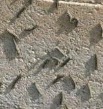Eighty-one-year-old James Cobb finds mowing, raking and baling hay relaxing. Finding his fields infested with tiny armyworms has the opposite effect.
‘‘I pulled up to my field, and it looked like someone had pulled a truck out of the field and left tracks on the road. They weren’t tracks. It was tons of those darned worms traveling up the road,’’ said Cobb, a small-scale farmer in Spalding County.
Cobb had planned to cut his field once more this season. The worms had other plans.
Almost every year in late summer, armyworms invade grass in home lawns and in hay fields and pastures across Georgia.
‘‘They often cause severe damage in late summer or fall after migrating populations have increased during the season,’’ said Will Hudson, an entomologist with University of Georgia Extension. ‘‘In lawns, they usually just cause aesthetic damage. In pastures and hay fields, they reduce yields and even eliminate late cutting of hay. And, cows can’t eat what the worms already got.’’
The caterpillars attack a wide range of plants, but prefer turfgrasses. They feed above the ground and mostly eat foliage and tender stems. ‘‘In severe cases, armyworms can cut grass down to ground level, leaving bare circular patches,’’ he said.
Adult armyworm moths are active at night. Females lay eggs in masses of 50 to several hundred. Eggs hatch in a few days, and the young larvae begin to feed on leaf tissue. As the worms grow, they eat entire leaves.
Caterpillars are most active late in the day and at night. They spend the hotter hours near the soil in the shade. Larvae feed for two to three weeks before pupating in the soil.
Moths emerge 10 to 14 days later. The entire life cycle----from egg to adult moth----takes about 28 days in the warm weather of August and September.
To test for armyworms, Hudson uses soap and water. ‘‘Mix a half ounce of dishwashing soap with a gallon of water and pour it on the grass. If the worms are present, they will quickly come to the surface,’’ he said.
Pax Evans didn’t need soap and water to tell his lawn was infested. Evans lives next to a dairy farm where bermudagrass is grown for hay. The worms ate through the hay fields and traveled to Evans’ lawn.
‘‘We went to bed one night and woke up the next morning to tons of worms all over the side of our house,’’ he said. ‘‘And, they had eaten the whole lawn down to just nubs of grass.’’
Evans spent the weekend spraying Spectracide to control the pests. Hudson says controlling armyworms and other turf caterpillars is relatively simple once the problem is identified.
‘‘The old standby carbaryl (Sevin) still works well, as do all the pyrethroids and products containing spinosad. Newer products like Acelepryn offer longer control, but at a price,” he said. Pyrethroids are the active ingredients listed on a label that end in ‘‘-thrin.’’
No insecticide is really effective at controlling large caterpillars, so Hudson says target the worms while they are still small.
“If the worms are detected while they are still small, Dipel, or other Bacillus thurengiensis(Bt)-based products, provide good control,” he said.
Since armyworms are most active late in the day and at night, apply pesticides as late in the evening as possible. An application rate of 20 to 25 gallons of solution per acre as a minimum will ensure good coverage, Hudson said.
With any insecticide, follow all label directions to minimize effects on bees and other pollinators. There is no need to water after applying pesticides and do not cut the grass for one to three days after application.
Researchers in the UGA College of Agricultural and Environmental Sciences are searching for armyworm resistance in zoysiagrass, a warm-season turfgrass that is growing in popularity.
They fed armyworm larvae grass clippings from 46 zoysiagrass taxons. Twenty-two zoysiagrasses showed 20 percent or less survival rate.
The next phase of the project will be testing whole plants in the greenhouse and fields.
The scientists are also looking for varieties that are resistant to tropical sod webworms, tawny mole crickets, chinch bugs, two-lined spittle bugs and other turfgrass pests.
‘‘Identifying and using resistant turfgrasses is an important component of integrated pest management as they reduce the need for pesticides,’’ Hudson said.
For more information on controlling pests in turfgrass, go to www.GeorgiaTurf.com.










